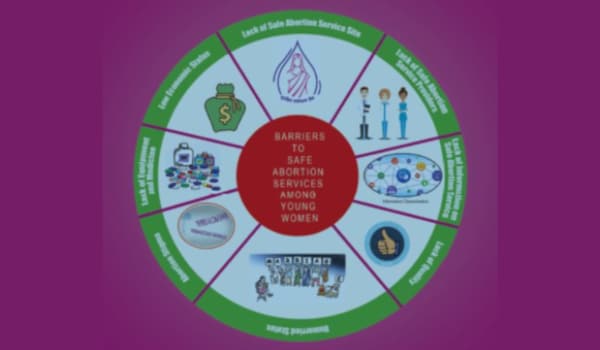
by Beyond Beijing Committee, Nepal
Executive Summary
Induced abortion is a global concern commonly experienced by women of reproductive age due to unintended pregnancy. Nepal legalized abortion in 2002 and started providing safe abortion services (SAS) free of cost, since 2016 from the certified government health facilities. But, more than half (58%) of the total induced abortion were reported to be done clandestinely in 2015. Young women and adolescent girls are at high risk of unwanted pregnancies that they often resort to unsafe abortion when they cannot have access to safe abortion. Lack of availability, accessibility, acceptability and quality services hinders those women to exercise safe abortion.
In Nepal, according to the NDHS 2016, the median age at first sexual intercourse is 17.9 years among female. The objective of this study was to assess the barriers to accessibility and availability of safe abortion services among young women in Makawanpur district. This study was conducted in Makawanpur district of Province No. 3, comprising 37% of the female population between 15-34 years of age. This district was purposively selected because the CPR is only 44% which largely increases the risk of unintended pregnancy. However, only around 2% of the safe abortion was conducted in the district in 2016. This may suggest that a huge number of women are still practicing unsafe abortion or continuing the unintended pregnancies. This district has been purposively selected for the study considering its difficult geographical terrain, lack of easy accessibility to government health facilities, high abortion rate, and diverse ethnic group with a highly marginalized ethnic population. The selected municipalities represent both rural and urban areas, including hills and plain areas of the district. In the selected areas, there are total of 51 public health facilities: one Public Hospital, 4 Primary Health Care Centres (PHCC), 40 Health Posts, one Community Health Unit and 5 Urban Health Centres.
A mixed method comprising both qualitative and quantitative was adopted. The qualitative information has been collected through focus group discussions (FGDs) and in-depth interviews (IDIs) whereas quantitative information has been collected through a survey. The study population for both types of study included young women aged between 18 and 34 years. Secondary data regarding the availability of the safe abortion was collected from the District Health Office, Makawanpur using a standard format developed by BBC. Ethical approval was taken from the Nepal Health Research Council (NHRC), respective local government authorities and colleges prior to the study. Additionally, informed consent was obtained with the study population before collecting the data.
Nearly 71% of the respondents were found to be aware of the legalization of abortion. Three-fourth of the respondents reported they knew the site where safe abortion service is available. The quantitative study showed that only 54% of the respondents had higher access to safe abortion services. The multivariate analysis showed that exposure to the internet, contact with Female Community Health Volunteers (FCHV) and abortion stigma were significantly associated with access to safe abortion services. The findings of both qualitative and quantitative findings suggested that the use of safe abortion services among young women can be remarkably increased by raising awareness, reducing abortion stigma, expanding SAS sites, improving the quality of safe abortion services through a multi-sectoral approach, and strengthening the evidence-based advocacy.
This research is part of State of the Region Report on Sexual and Reproductive Health and Rights: International Conference on Population and Development (ICPD+25) monitoring initiative by ARROW. This initiative includes 13 partners and generates monitoring evidence around 25 years of implementation of the ICPD Programme of Action in the respective countries for advocacy. The evidence from the report is expected to inform the Mid-term Review of the 6th Asia Pacific Population Conference (APPC) in 2018 at the regional level, the national policy dialogues in 2019 at the national level, and the ICPD+25 review in 2019 at the international level.
Photo Credit: Government of Nepal and Internet Graphics



